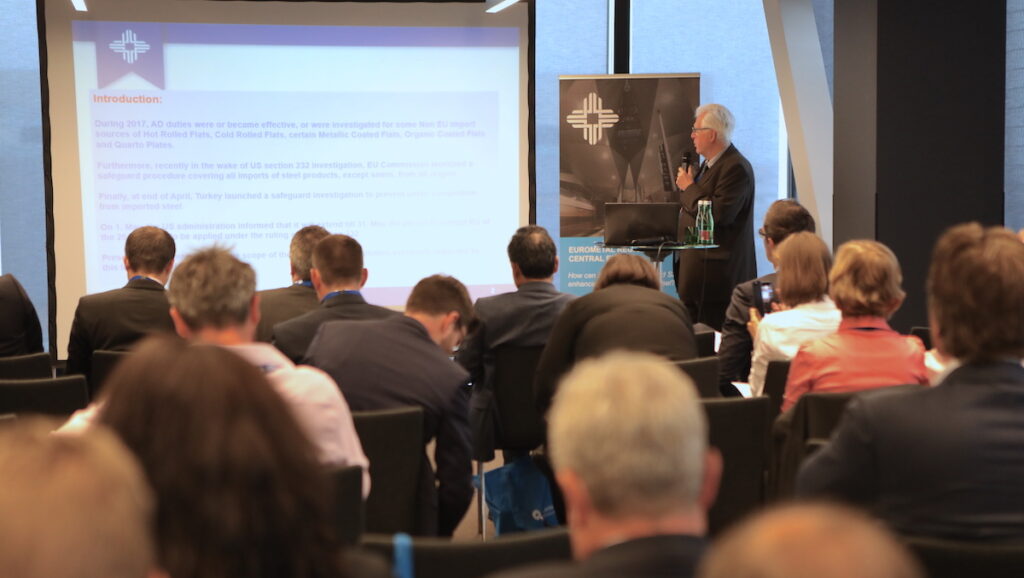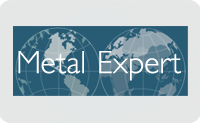
EUROMETAL: Distributors see global protectionism key risk for industry
The participants of EUROMETAL’s Central Europe Regional meeting of steel distributors on May 14-15 in Vienna addressed the problem of increasing value of steel by distributors and steel service centres (SSC), as well as the main challenges and opportunities the industry is facing now. The meeting was attended by more than 50 industry representatives from Central and Eastern Europe, including the producers and independent SSC and distributors.
Accessing the situation in the Central and Eastern European steel distribution during the meeting attended by Metal Expert participants agreed that the global protective measures currently pose a major threat to the European steel market. New EU safeguard measures, if applied, will reduce imports, thus aggravating the situation in the distribution sector in terms of supply balance, Metal Expert understands. All distributors and SSC are dependent on imports; they need imports in addition to the material they buy from the EU mills, otherwise they lose their competitive edge. “Independent distributors are back bone of the industry…We have solid function in the market…Yet, now there is a danger, not only in terms of AD cases…, now we have that safeguard investigation, which is a general attack on imports,” Ralf Reintjes, managing director of German trader Primex Steel and ISTA executive committee member, said. There has to be a healthy mixture between imported and EU-produced steel, which is hard to achieve in terms of ongoing AD cases, participants agree.
Some speakers believe that currently mills are better-positioned in the market than independent players, partly because of trade measures. “I don’t think independent SSC have such a bright future. We could see that during the AD procedures. There was a fight between integrated mills and independent SSC, and now it is really for the favour of integrated mills what we see in Europe at the moment,” Roland Fazekas, president of Hungarian stockholding company Carboferr, opined.
There was an opinion voiced during the discussion that independent steel distributors need a body to represent them in trade cases, like Eurofer for the mills. “We are simply to small…we need an independent body which can represent us in cases like safeguard investigation, AD cases, because such organizations have voice,” Ralf Reintjes added.
It is worth noticing that the EU launched a safeguard investigation into all steel imports, except for semis, from all origins, in a response to the US Section 232 case. This investigation is expected to have a major influence on flat steel products. Last year, steel imports volumes sent to the EU reached 29.4 million t, with flats constituting 69% of that volume, EUROMETAL director general Georges Kirps showed in his presentation. Even though the flats imports situation has stabilised since the imposition of safeguard measures in 2016-2017, overseas deliveries are not going down significantly. Lower shipments from the counties covered by AD measures have been offset by those from other regions. “Non-EU import flow changed by imports sources, owing to imposed AD measures,” Kirps said.
Sometimes, even the protective measures are not enough to fully stop imports, like in case with Russia that managed to increase HRC deliveries to Europe from 23,000 t in January-March 2017 to 420,000 in Q1 2018, despite the AD applied. “Certain Russian company, Severstal, has a low antidumping [rate] and runs SSC in Poland and Baltic region. So one of the explanations for that is increased deliveries mainly to Poland and Baltics for their own assets,” Kirps noted.
In a wake of increasing steel imports volumes to the EU in recent years competitiveness has become one of the key issues for the local steel market participants. For the EU distributors, the crucial differentiating factor from imports remains the range of services they can offer. From that point of view, the cooperation between mills and the SSC is essential for the steel market, especially, in the current situation, when there is no longer a clear split between the distributors’ market and the mills’ market. “Now mills just go directly to our customers, it’s complete chaos,” a European distributor told Metal Expert.
At the same time, distributors are more flexible than mills as they buy material from different sources and can deal with small tonnages which mills usually don’t do. “Mills will never be able to provide the same level of services as SSC,” Gabriel Holub, sales manager at U.S. Steel Kosice said during his presentation. The sustainable cooperation between mills and distributors can increase value of steel supply chain. “As the largest integrated mill in the Central Europe and without our own distribution network, the cooperation with SSC is a natural part of our business,” he said.
Despite the mentioned risks, many participants agreed that prospects for independent SSC are rather optimistic. Among the advantages of distributors is their consistent approach to the market. A relative value that they apply to the customer as an independent SSC is probably greater than the mills would give. “We are more flexible to satisfy specific customer demands,” Garry Furey, general manager of Czech service centre Mi-King said. Apart from a range of services the mills cannot provide, the distributors can also handle small tonnages which mills would not deal with. These competitive strengths are putting the distribution sector in a good position in the steel market, Metal Expert understands.
Speaking of the main opportunities for independent SSC, the meeting participants addressed digitalization as one of the key competitive advantages for a short-term perspective. Launching online platforms allows them to achieve greater customer acquisition, cut costs, improve warehouse management and logistics routing, to increase value of a supply chain. “Digitalization is a first step towards Industry 4.0….In digitalization we see a huge potential, may be not now, but for the future – definitely,” Dr. Jan Moravec, member of the board of Ferona, mentioned during his speech.
“We are trying to standardize our processes and digitalize whatever we can in our organizations. We gain a lot of time in terms of customer service by applying automatized processes,” one of the participants said during the panel discussion. Besides, the participants mentioned that for the future prospects it is important for a steel distributor to offer its customers a wider range of material – not only steels, but also a supplements, including plastics, aluminium etc. “If you have a full package of steel and supplement materials, for end-users, it’s also a value-added kind of service you can offer, which distinguishes your company from the others,” one of the distributors said.
EUROMETAL includes 18 national associations and represents interests of about 3,000 steel distributors and service centres. Among the upcoming regional events organized by EUROMETAL is SSC Meeting Southern Europe in Barcelona on June 28. The meeting will address the ways SSC can enhance the value chain of steel, key challenges and opportunities the independent SSC in Southern Europe are facing now.
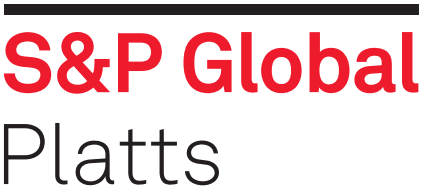
Italian service centers under pressure as margins decline
Italian steel service centers (SSC) remain under pressure, with the first five months of 2018 seeing very little demand, particularly from end-users, according to sources.
2018’s shipment volumes are lower than 2017’s, sources say. In addition, margins are being squeezed. Mill prices have fallen consistently, by about Eur20-Eur25/mt, over the last two months, but SSCs have had to cut their prices by even more – around Eur40-Eur50/mt, a source at a large Italian service center said.
“Obviously this bigger SSC price reduction is penalizing the SSC margin, which is not sustainable any more, and needs to rise urgently, even if the demand isn’t helping and some uncertainty is still present in the market” he added.
Even with slow demand and shipments, SSC stock levels have decreased over the last three months and, as a consequence, SSCs are little by little entering the market, sources say, with the main purchases expected in the coming weeks.
Margins fell because SSCs are having to sell at least Eur30-35/mt below where they make any money, while mills have started to decrease their prices to entice buyers, but also due to pressure from imports.
“Domestic prices have moved down as end-users continue to resist any price rises from distributors, with SSCs not fully absorbing mill price increases in the first quarter,” another source said.
The price of hot-dip galvanized sheet from Italian mills fell the most, around Eur10/mt week on week, to Eur620/mt base substrate, ex-works, according to Platts-TSI data, as a result of an excess in supply.
Cold-rolled coil prices fell Eur5/mt to Eur615/mt base ex-works, according to Platts data, on pressure from Turkish imports, with some seen at Eur620/mt CIF Italian ports, based on a Eur/$ exchange rate of 1.18, traders said.
Domestic Italian hot-rolled coil prices were reported to be around Eur520-Eur530/mt base ex-works, down from Eur550-Eur560/mt four weeks ago. HRC prices dropped, but by a smaller amount than HDG as there is less supply. Buyers last week bid at Eur520/mt ex-works and some mills have dropped below even that mark.
Annalisa Villa, PLATTS
ASSOFERMET – Le nuove cariche sociali
Nella giornata di ieri a Milano, presso la sede del Consiglio Nazionale delle Ricerche (CNR), si sono svolte le Assemblee elettive ASSOFERMET per il Triennio 2018-2020.
Dopo ben 12 anni di mandato del Dott. ROBERTO LUNARDI, la Presidenza dell’Associazione ha visto il passaggio del testimone al Dott. RICCARDO BENSO,
Presidente di Albasider Spa, che lavorerà affiancato al riconfermato Vice Presidente, Dott. MICHELE CIOCCA. Mantenere e proseguire la collaborazione con i vertici di tutti e quattro i Settori di ASSOFERMET al fine di migliorare sempre di più i servizi alle Aziende, restando vicini alla base associativa, è senza dubbio uno degli obiettivi primari del nuovo Presidente.
Scelta di continuità per i Presidenti e Vice Presidenti di ASSOFERMET ACCIAI, ASSOFERMET ROTTAMI e ASSOFERMET METALLI che hanno visto la riconferma rispettivamente di TOMMASO SANDRINI e DAVIDE FERRARI (Acciai); PAOLO POZZATO e LAILA MATTA (Rottami); CINZIA VEZZOSI e ALBERTO SCURATI (Metalli).
Eletta per la prima volta una donna alla Presidenza di ASSOFERMET FERRAMENTA, SABRINA CANESE, che sarà affiancata dal Presidente uscente MICHELE TACCHINI.
Milano, 24 maggio 2018

EU growth continues but slower, tariffs needed: USSK

Despite its slowing pace, continued solid economic growth in the EU, even stronger in the Visegrad 4 countries, will stimulate steel demand beyond 2018. However, the EU needs trade measures to protect against steel redirected by US Section 232 tariffs. So said US Steel Kosice (USSK) sales manager Gabriel Holub at the Central Europe regional meeting of distributors’ association EUROMETAL.
Overall EU economic fundamentals are robust thanks to private consumption supported by a strong labour market, combined with moderate inflation and expected acceleration of disposable income, according to Holub. EU steel use should rise over 2% on-year in 2018.
Between now and 2022 V4 automotive sector output is expected to grow 20% due to shift in production at major OEMs and better capacity utilisation. “It is a very nice growth which should be translated into a steady growth of steel consumption and increase of related services,” Holub said at last week’s meeting attended by Kallanish.
EU white goods output, too, is seen strong. “There is also a visible very strong commitment from OEMs to research innovations, so with more new products coming to the market, in the future we can expect that this sector will be staying, from a demand perspective, healthy and strong,” he added.
EU steel imports rose in the first quarter, notably from India and Turkey, after falling in the second half of 2017. “The level of imports is expected to be balanced in the near future even if there is currently a period of higher uncertainty mainly linked to US Section 232 tariffs and risk of redirection of volumes to Europe from countries which cannot export to the traditional destinations,” Holub observed. Many European customers have turned to local suppliers in the current period of uncertainty, he added.
The “… balanced” import situation, coupled with increased raw materials prices, should result in continued healthy steel prices in 2018, the manager explained.
Holub warned, however, “… it is necessary to react in order to protect the European steel market from potential huge surge of imports from countries which are hit by measures elsewhere globally.”
He concluded by saying European mills and distributors should cooperate to better manage periods of uncertainty and changing end-user requirements.

Benelux service centre plans further expansion
Dutch-headquartered steel service centre Roba Metals is planning to expand its storage facilities for stainless steel, following other investments implemented in 2017.
The company with sites in the Netherlands and Belgium processes carbon as well as stainless steel strip. Roba’s Stainless Division plans to add a new warehouse for sheet in 2018, with an area of 5,000 square metres, Kallanish learns from managing director Florin Negulescu.
The unit normally carries stocks in excess of 10,000 tonnes, and in 2017 produced 42,500 tonnes of cut-to-length sheet with a staff of 30. Stainless activities are mainly located at the company’s headquarters in Ijsselstein, Netherlands, but also in Genk, Belgium, where the new warehouse will be built.
Roba spent €4.0 million ($4.7m) last year on a new warehouse for mother coil with an area of 4,000 m² at its (carbon) Steel Division in Genk where it employs 50 personnel. It also installed a new leveller for the CTL line which cost €800,000. In 2017, the unit produced 92,000 tonnes of slit strip and 35,000 tonnes of cut-to length sheet. Its normal stock level is above 30,000t.
Roba Metals was established in 1937 and was initially involved in recycling. This continues to form part of its activities, with the focus on non-ferrous metals. It has a recycling centre in Warwickshire, UK, and also has sales offices in Krefeld, Germany and Olawy in Poland.

Stemcor returns to profit in 2017
UK trader and distributor Stemcor Global Holdings has reported a year-on-year fall in sales volumes but increases in total revenue and Ebitda as the group returned to profit in 2017.
In a statement of its annual results to 31 December 2017 monitored by Kallanish, the company says that “… The results highlight continued positive operating results, a turnaround in market conditions and Stemcor returning to consolidated Group profit for the first time since a major restructuring was undertaken in 2015.” This was assisted by “… disposal of non-key assets to focus on key business activities.”
Group ceo Steve Graf is equally upbeat. “Our hard work and dedication following the restructuring of 2015 has delivered a strong set of numbers that reflect a focus on improved margin realisation and market conditions. In addition, a strategy to focus on our core trading activities resulted in the successful sale of a number of business units during the year, enabling the refinancing of the rest of the group,” he says.
Sales volumes of steel and raw materials fell by -15% y-o-y to 3.7 million tonnes, Stemcor confirms.
Total revenue for full year 2017 increased however by 8% to $2.11 billion versus $1.96 billion in 2016. Adjusted group profit before tax of $19 million was achieved, recovering soundly from a loss of $3.2m in 2016. Ebitda rose by a significant 45% y-o-y to $48m on the same comparison.
The group also welcomed the appoinment of its new non-executive chairman, Martyn Konig.
Construction sector liquidity worries Polish distributors
Polish distributors are prepared to meet rising domestic steel demand, but there are worries over delayed payments in the construction sector. This was the opinion voiced by the steel distributors’ panel at the European Economic Congress in Katowice.
Chief executive of Polish distributor giant Konsorcjum Stali Janusz Smolka said most distributors should be able to cope with the requirement for increased working capital resulting from higher steel prices. The near-future outlook for Polish and German economic growth is bright, he added, although Polish steel demand growth will slow on-year in 2018.
However, there are some concerns over the construction sector. “The number of construction firm bankruptcies is increasing,” Smolka said during Wednesday’s panel attended by Kallanish. Those construction firms whose projects are now concluding with losses did not foresee there would be a 60% increase in steel price since 2016. “I don’t know how construction firms will deal with investors and with indexing this, but I imagine there will be problems with this increase in prices… However, I reckon this will not change the fact that we will realise these construction projects anyway.”
Jerzy Bernhard, chief of Polish distributor Stalprofil, re-iterated Smolka’s warning, saying that steel structures fabricators who supply the construction industry will increasingly delay payment to steel suppliers. Many will go bankrupt or be forced into restructuring, he added.
Meanwhile, Robert Agh, chief executive of distributor Ferona Polska, pointed out that, contrary to earlier forecasts, there has been no consolidation in Poland’s distribution sector. Poland has around 20 competitive distributors, 16 of which are in some form of purchasing alliance. This results in a “… Polish heaven” when prices are strong and all these firms are making good margins, but a “… Polish hell” when prices drop as the competition between the suppliers is intense. Agh fears any reduction in demand could lead to the latter scenario.
In terms of the future for the distribution sector, Jakub Grobarczyk, board member at Polish service centre Serwistal, said most distributors have invested in processing. This is because their customers require a greater degree of specialisation. “We’re not just talking about regular cutting or bending rebar, no, this is complexity of supply, complexity of realising a given project with our customers,” he opined. “This is a direction from which we will no longer return.
Bernhard added that distributors must invest in increasing the efficiency of truck loading systems, as often lorries are forced to wait 24 hours at stockyards before loading product.
Another hurdle for Polish distributors is labour shortages. Smolka pointed out a shortfall in lorry drivers has raised distributors’ freight costs. Agh explained that Western firms moved their manufacturing bases to Poland and the Czech Republic many years ago when labour costs were cheap, but their economies have since grown rapidly and labour shortages are now frequent. The situation in the Czech Republic is still worse, he emphasised, because Poland at least has a reserve of 2.5 million expatriates it can repatriate when wages rise.
Kallanish
Polish distributors fear EU safeguard impact on competitiveness
EU safeguard duties are required to protect against steel diverted by Section 232 and maintain market stability, although there are concerns rising protectionism could limit buyers’ competitiveness. This was the opinion voiced by the steel distributors’ panel at the European Economic Congress in Katowice.
Although the effect of US tariffs on EU exports is limited, Turkey, which sits on the EU’s doorstep, may be levied with US tariffs and will need to find alternative markets for its huge long products output. This means it is likely the EU will implement trade measures, Jerzy Bernhard, chief of Polish distributor Stalprofil, said during Wednesday’s panel attended by Kallanish.
Jakub Grobarczyk, board member at Polish service centre Serwistal, however, warned that increasing protectionism may hurt some steel companies. While duties are justified for steelmakers, “… on the other hand they will lead to largely restricted accessibility,” which “… could impact the competitiveness of our products and the final products of our customers.” The approach to trade defence must therefore be “… rational.”
This view was immediately countered by Tomasz Plaskura, ArcelorMittal Europe – flat products business division east chief marketing officer. “We are convinced that we can compete with every importer in terms of cost, quality and customer service, as long as the competition is fair,” he observed.
“Safeguard measures are protectionist barriers implemented to prevent a sharp rise in imports, which means the import we see today will most probably remain on the same level,” Plaskura continued. EU steel imports have increased further in the first quarter of 2018, “…so it’s hard to speak about difficulties in access to material,” he added. Despite the EU’s trade defence measures so far, the region remains one of the most open to imports, the official added.
Kallanish
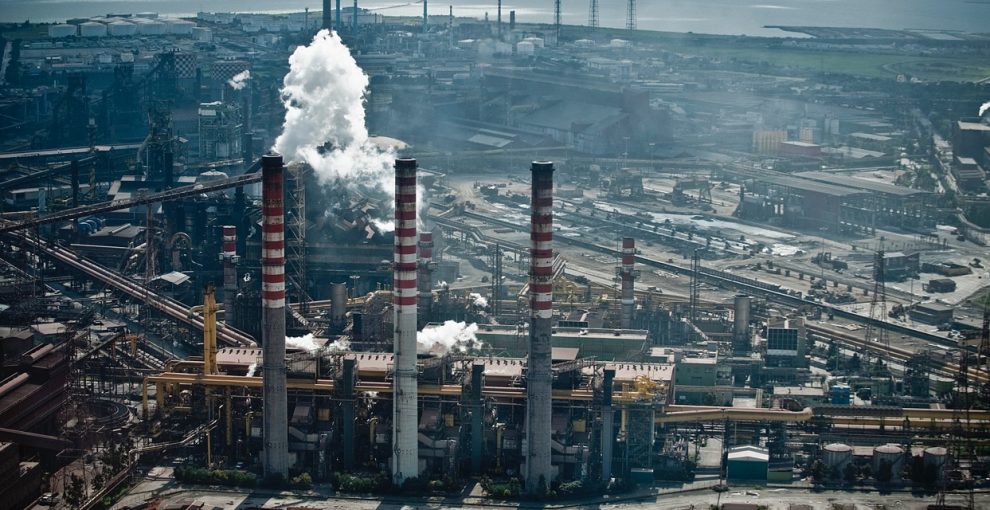
Assofermet urges institutions to speed up Ilva acquisition
The acquisition and modernisation by ArcelorMittal of Italian steel maker Ilva’s Taranto site will strongly benefit the entire steel value chain in the country according to the Italian steel association Assofermet. In particular, it will benefit the many steel end-user sectors in the Taranto region, the association adds. It is urging all the parties involved to speed up the process for the site’s re-launch.
The Ilva acquisition by ArcelorMittal represents today the best option for a smooth production continuity of Taranto, Assofermet continues. The heavy disruption in Ilva’s production volumes has led to major supply difficulties for both domestic end-users of steel and re-rollers. Taranto’s heavy production cuts have resulted in booming imports and an unbalanced market in term of prices, demand and supply., the association says in a note sent to Kallanish.
Italy for instance could only count on Marcegaglia and Arvedi for the [… domestic] supply of flat products and tube. Despite the “… excellent work” done during the crisis years for Italian steel, they are not able to satisfy – by type and volume – the entire demand from the domestic market. Bringing Ilva’s output back to the volumes of the past will enable the country to respond to its domestic demand, and produce timely delivery with better price competitiveness, Assofermet says.
With its significant resources, ArcelorMittal is able to deploy the technical and managerial leadership necessary to bring back Taranto to its full performance of the past. In relaunching Taranto, ArcelorMittal’s objective is to make the plant its main production platform in the Mediterranean for ‘clean’ steel. However, only continuity of production in Taranto will allow environmental rehabilitation to be achieved, the association contends. Should activities terminate and the site close, the risk of degradation and complete abandonment of the area is very high, Assofermet warns.
Kallanish
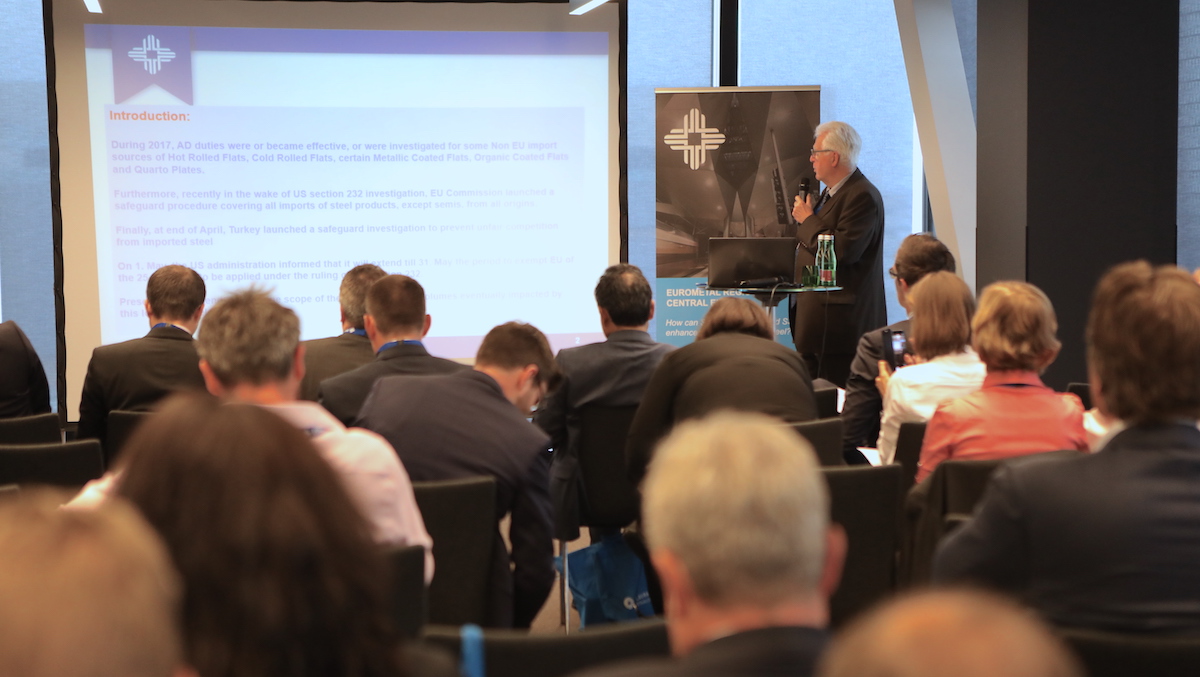
EU duties seen altering trade, CRC/coated replaces HRC
The potential imposition by the EU of import tariffs following its steel safeguard investigation could simply see transformed steel-consuming products enter Europe instead of duty-levied steel. So said EUROMETAL director general Georges Kirps at the distributor association’s Central Europe regional meeting this week.
There is also the question of whether Switzerland and Norway will be levied with any resultant measures, as they supply a significant tonnage to the EU, Kirps said.
In any case, trade defence measures should be clearly thought through as they have a big impact on supply chains, he added. The EU safeguard investigation omits semis but covers all other steel products, the imports of which into the EU amounted to 29.4 million tonnes in 2017, level on 2016. The main impact of the probe will be on flat products, which in 2017 had a 69% share in imports of the products covered by the investigation.
Last year EU imports from non-EU sources of hot rolled flats except for quarto plate fell -18% on-year to 6.97mt, while quarto plate imports declined -11% to 2.46mt. This was, however, offset by a 24% rise in cold rolled flats imports to 2.46mt and 26% rise in metallic coated flats imports to 4.96mt.
Hot rolled coil imports in 2017 from Russia declined by -65% to 722,000t, from Ukraine by -38% to 666,000t and from Brazil by -44% to 371,000t. These countries were hit by anti-dumping duties. They were, however, partially offset by a rise from Turkey, India, Egypt, Taiwan, South Korea, and Serbia.
Cold rolled coil imports from AD duty-levied countries, Russia, Iran and China, also dropped in 2017, and were partially offset by an increase from India, Vietnam, South Korea, Ukraine, and Brazil.
In the first quarter of 2018 HR flats imports nevertheless rose 15% on-year to 2.08mt, driven by Russia supplying 420,000t versus 23,000t in Q1 2017, despite being levied with AD duties. Imports from Turkey also rose 56% to 731,000t and from Serbia by 144% to 205,000t.
The Russian rebound is because “…Severstal has a low anti-dumping duty and has service centres in Poland and the Baltic countries,” to which it has increased supply, Kirps suggested at the Vienna meeting attended by Kallanish.
The EU import data doesn’t tell the full story, moreover. A large portion of product imported into Italy and Spain is done so by either import-dependent re-rollers or mill-tied processors. This product is not traded on the open market. In addition, only a minority of product imported into Belgium actually remains there, while the rest is trans-shipped to neighbouring countries, Kirps concluded.
Kallanish



